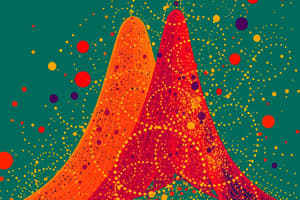Podcast
Questions and Answers
A researcher is studying the number of defective products produced in a factory per day. Which type of random variable is best suited to model this scenario?
A researcher is studying the number of defective products produced in a factory per day. Which type of random variable is best suited to model this scenario?
- Normal random variable
- Discrete random variable (correct)
- Continuous random variable
- Exponential random variable
Which of the following is NOT a property of a normal distribution?
Which of the following is NOT a property of a normal distribution?
- The curve is skewed. (correct)
- The curve is symmetric about the mean.
- The mean, median, and mode are equal.
- The total area under the curve is equal to 1.
A data set follows the empirical rule. Approximately what percentage of the data falls within two standard deviations of the mean?
A data set follows the empirical rule. Approximately what percentage of the data falls within two standard deviations of the mean?
- 50%
- 99.7%
- 95% (correct)
- 68%
What type of graph is typically used to visually represent a probability distribution?
What type of graph is typically used to visually represent a probability distribution?
A fair coin is tossed three times. What is the probability of getting exactly two heads?
A fair coin is tossed three times. What is the probability of getting exactly two heads?
Given the following probability distribution, what is the mean (expected value) of X?
X
0
1
2
3
P(X)
1/8
3/8
1/8
3/8
Given the following probability distribution, what is the mean (expected value) of X?
| X | 0 | 1 | 2 | 3 |
|---|---|---|---|---|
| P(X) | 1/8 | 3/8 | 1/8 | 3/8 |
Using the same probability distribution as the previous question, what is the variance of X?
X
0
1
2
3
P(X)
1/8
3/8
1/8
3/8
Using the same probability distribution as the previous question, what is the variance of X?
| X | 0 | 1 | 2 | 3 |
|---|---|---|---|---|
| P(X) | 1/8 | 3/8 | 1/8 | 3/8 |
Which statement best describes the relationship between the standard deviation and the variance?
Which statement best describes the relationship between the standard deviation and the variance?
Flashcards
Random Variable
Random Variable
A variable whose values depend on the outcomes of a random phenomenon.
Discrete Random Variable
Discrete Random Variable
A random variable that can take on a countable number of values.
Continuous Random Variable
Continuous Random Variable
A random variable that can take on an infinite number of values within a given range.
Normal Probability Distribution
Normal Probability Distribution
Signup and view all the flashcards
Mean
Mean
Signup and view all the flashcards
Variance
Variance
Signup and view all the flashcards
Standard Deviation
Standard Deviation
Signup and view all the flashcards
Empirical Rule
Empirical Rule
Signup and view all the flashcards
Study Notes
Random Variables and Probability Distributions
- A random variable is a variable whose value is a numerical outcome of a random phenomenon.
- Discrete random variables can only take on specific, distinct values (e.g., 0, 1, 2).
- Continuous random variables can take on any value within a given range.
- The normal distribution is a continuous probability distribution.
- The shape of the normal distribution is bell-shaped and symmetrical.
- A probability distribution is a table or graph that displays all probabilities of a random variable.
Probability Distribution Graphs
- A sample space is a set of all possible outcomes of an event.
- A probability distribution displays the probabilities associated with each value in the sample space.
Mean, Variance, and Standard Deviation
- Mean (μ): The average value of a random variable
- Calculated using the formula: μ=ΣX⋅P(X)
- Variance (σ²): Measures the spread of a probability distribution.
- Calculated using the formula: σ² =Σ (X−μ)²⋅P(X)
- Standard deviation (σ): The square root of the variance.
- Calculated using the formula: σ=√Σ (X−μ)²⋅P(X)
Normal Distribution
- A normal distribution is a specific type of continuous probability distribution.
- It's characterized by its bell-shaped curve centered on the mean.
- The mean, variance, and standard deviation of a normal distribution determine its shape and position.
Empirical Rule
- The Empirical Rule describes the percentage of data values that fall within a certain number of standard deviations from the mean in a normal distribution.
Studying That Suits You
Use AI to generate personalized quizzes and flashcards to suit your learning preferences.
Related Documents
Description
Understand random variables, including discrete and continuous types. Explore probability distributions, sample spaces, and normal distributions. Learn to calculate the mean and variance of a random variable.




